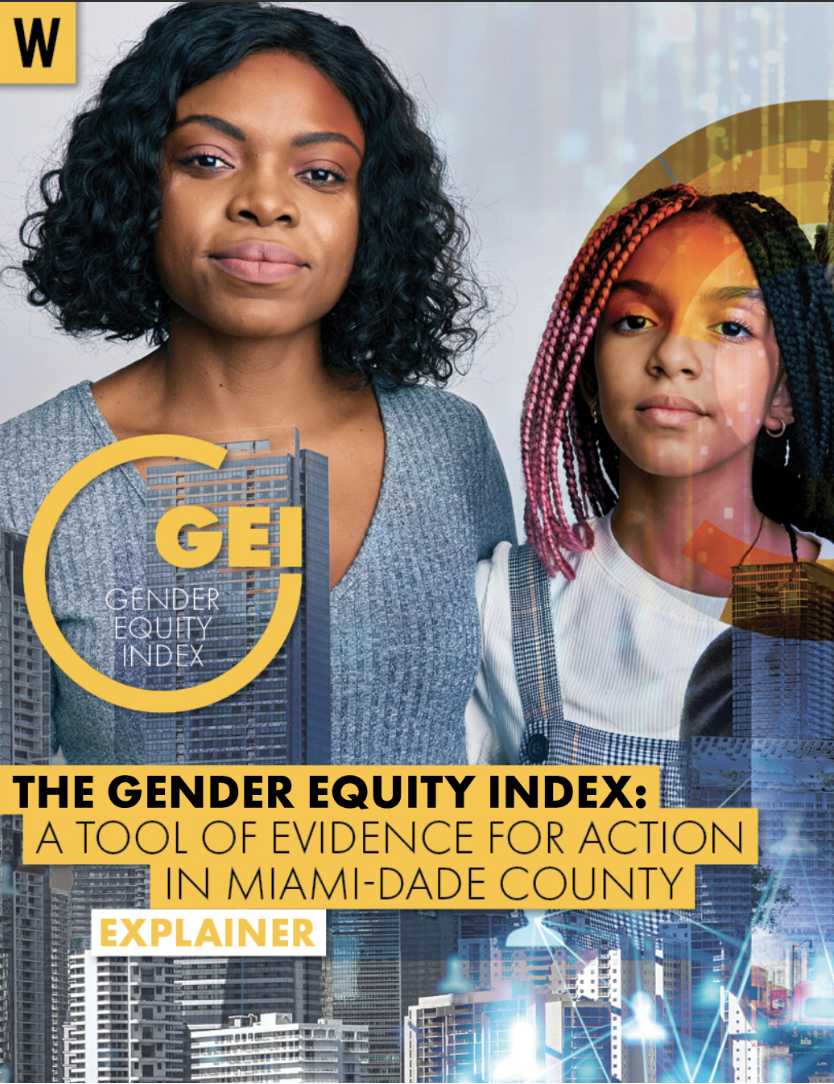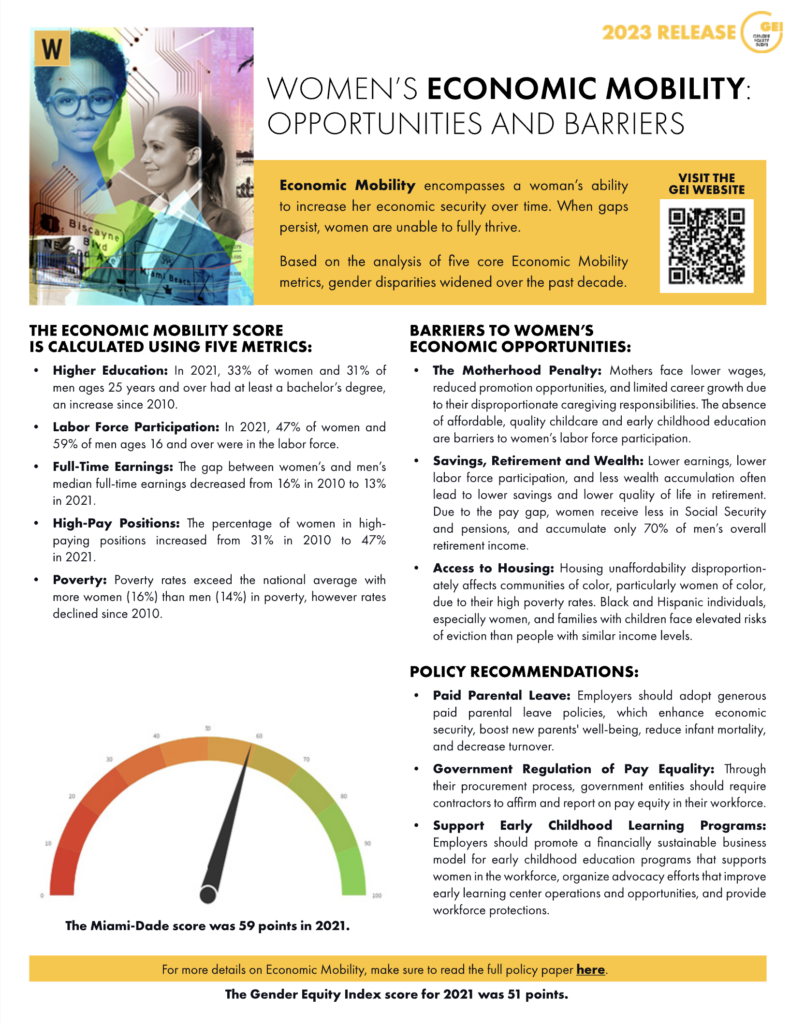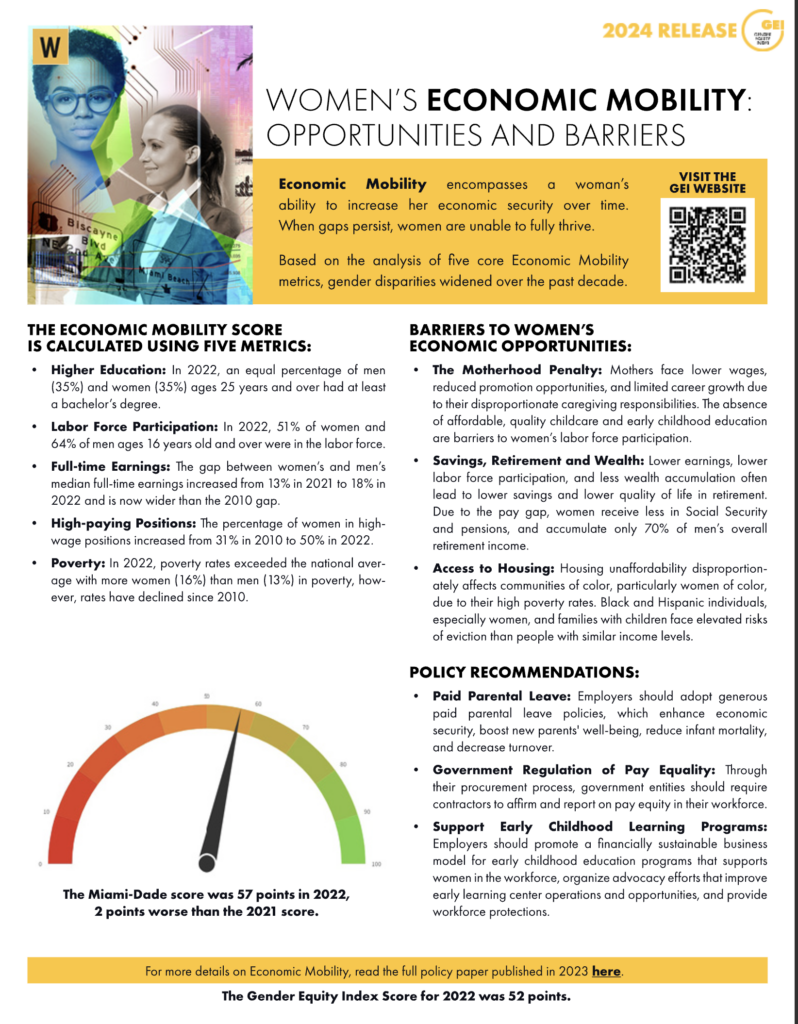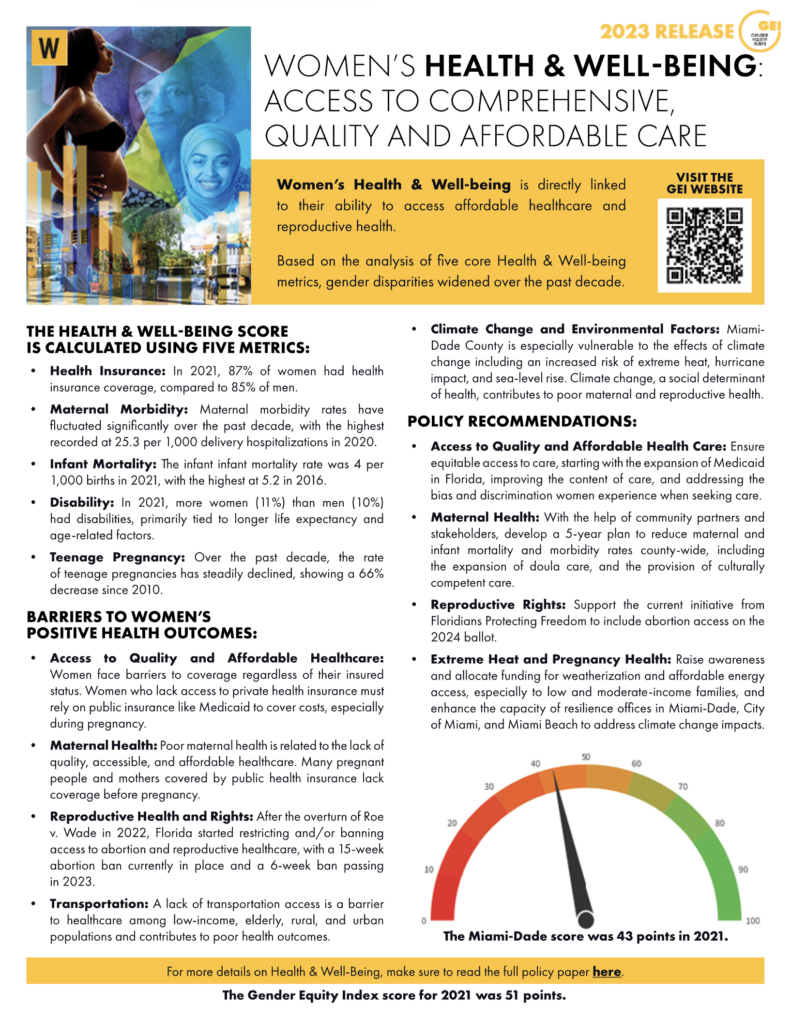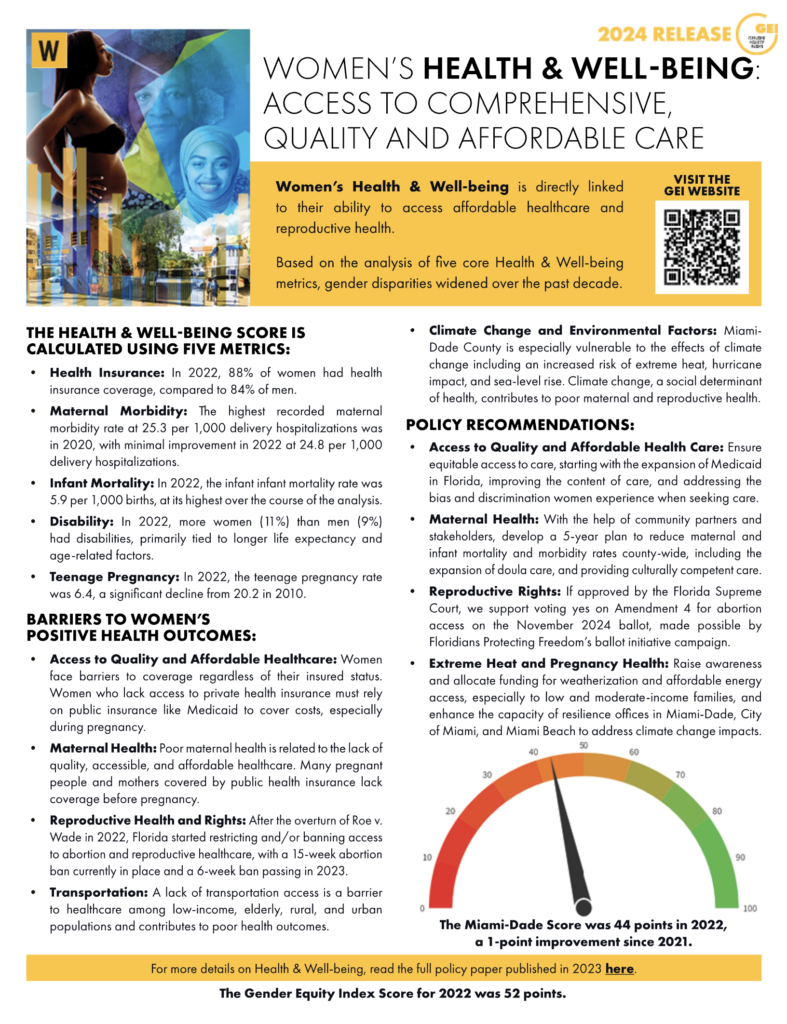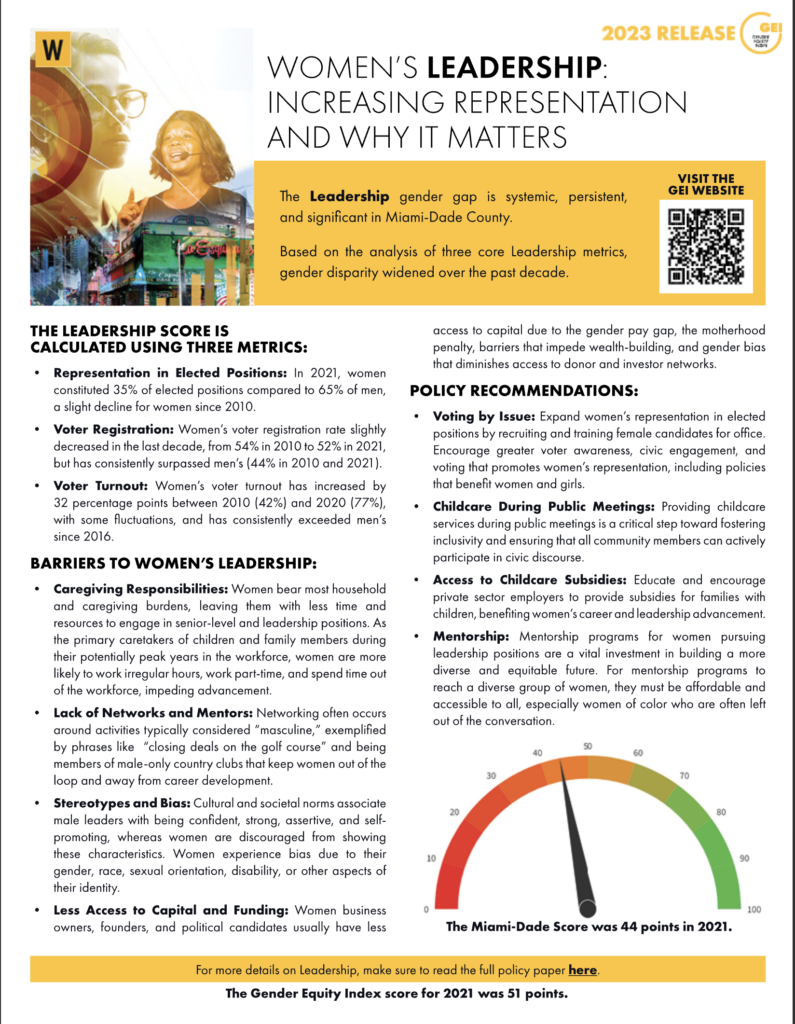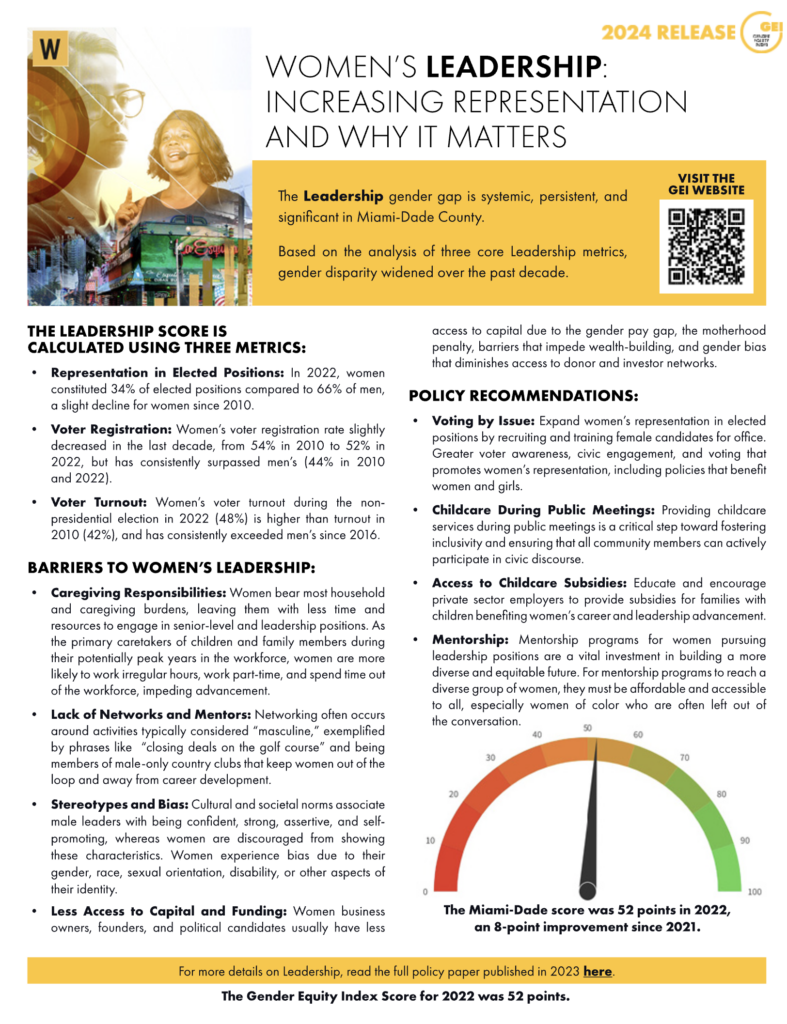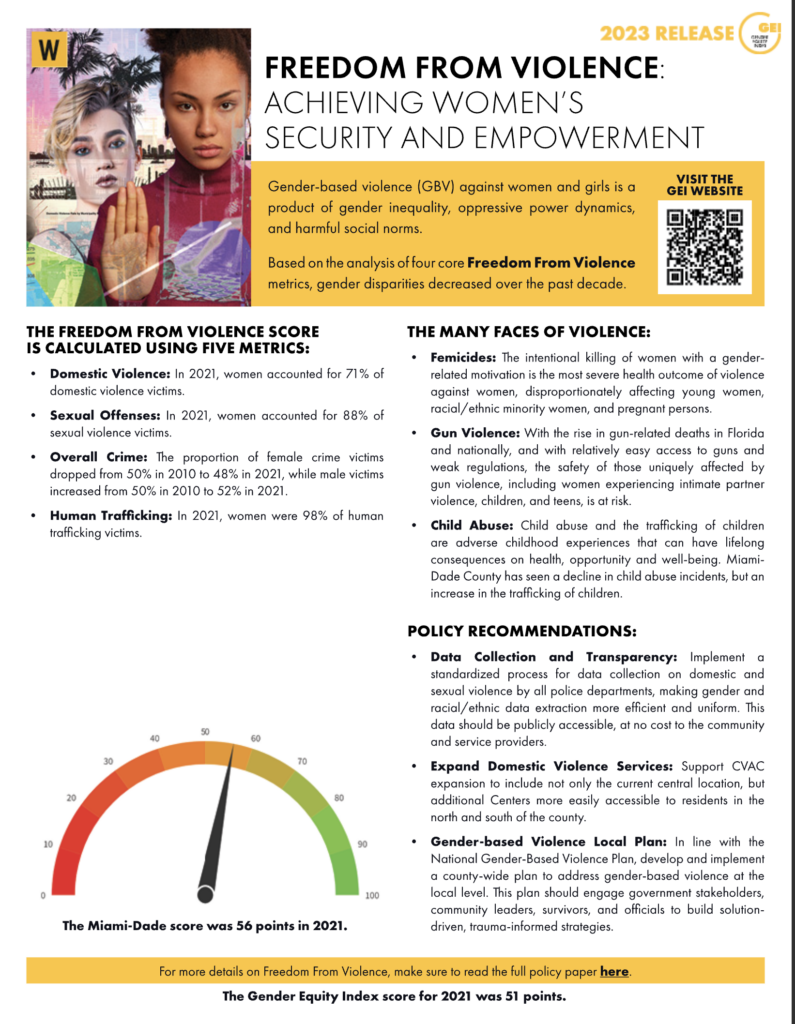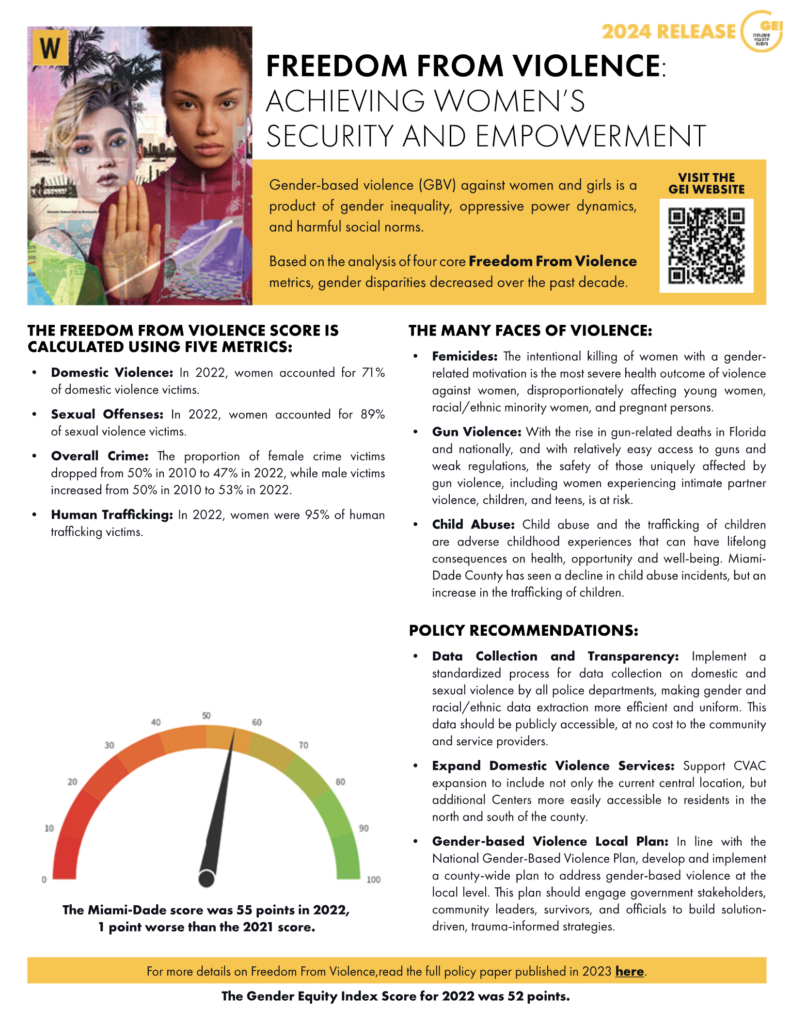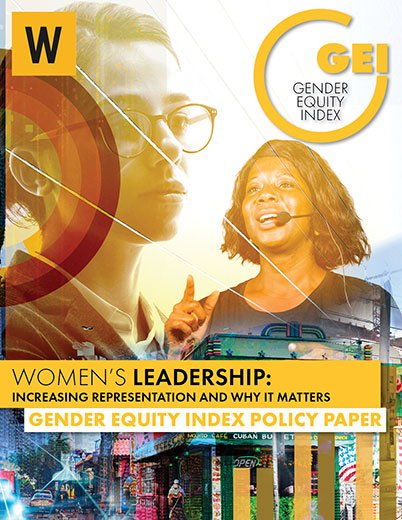GENDER EQUITY INDEX
The Gender Equity Index (GEI) measures progress toward equity for women and girls in Miami-Dade County. Its goal is to drive collaboration in the advancement of gender equality.
Persistent Inequalities Must Drive Change for Women’s Empowerment.
Gender Equity Index
2022 Score, 52 points
Miami-Dade is 48 points away from achieving gender equality.
Gender Equity Index Score
The Gender Equity Index score has barely changed over the past 12 years, reflecting little progress toward gender equity across its pillars—Economic Mobility, Health & Well-being, Leadership, and Freedom from Violence. At one point below the 2010 score, the 2022 score highlights stagnant progress.
The Gender Equity Index measures community progress toward gender equity in Miami-Dade County.Data drives action, decision-making, and policy changes.
- The GEI, based on an international model and applied for the first time locally, reflects that women and girls face interconnected challenges, as obstacles in each of the Women’s Fund Miami-Dade (WFMD) four pillars – Economic Mobility, Health and Well-Being, Leadership, and Freedom From Violence – affect outcomes in the other three.
- The GEI provides actionable data to inform and assist policymakers and the broader community in improving gender equality. WFMD’s policy recommendations at the end of each policy paper support data-driven collaborative and sustainable solutions to documented gender disparities.
Economic Mobility
- Full time employment
- Median full time earnings
- Bachelor’s degree or higher
- High pay positions
- Poverty
Health & Well-being
- Health insurance
- Maternal morbidity
- Infant mortalilty
- Disability
- Teenage pregnancy
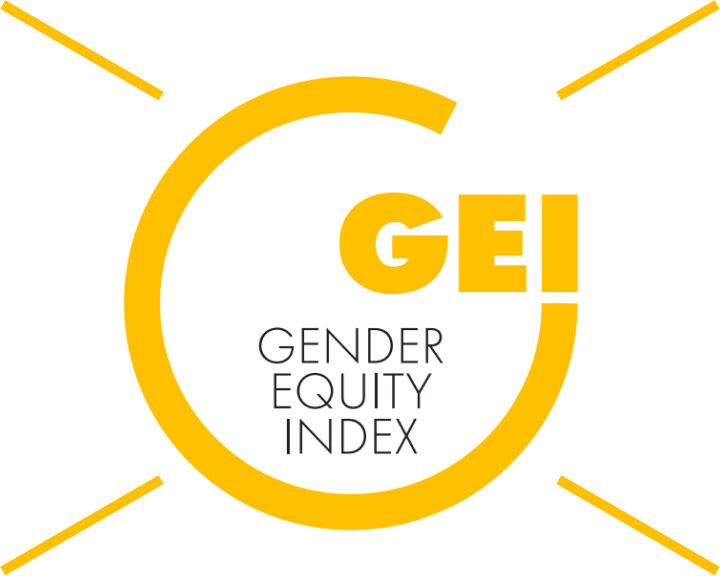
Leadership
- Voter turnout
- Representation in elected positions
- Voter registration
Freedom From Violence
- Domestic violence
- Sex offenses
- Overall crime
- Human trafficking
4
Pillars
16
Metrics
12
Years of Data
The Miami-Dade
Gender Equity Index:
A Tool of Evidence for Action in Miami-Dade County
The GEI explainer describes the Index, the rationale and methodology of its development, and why it’s necessary to achieve gender equity in Miami-Dade County. Each GEI score will be accompanied by a policy paper examining one of the four pillars of The Women’s Fund.
Quick Insights
Our one-pagers provide a snapshot of the key points, findings, and recommendations from our in-depth policy paper for each WFMD pillar. Whether you’re a policymaker, advocate, or simply seeking a quick overview, these concise documents offer a straightforward way to grasp the core content.
Economic Mobility
Women’s Economic Mobility Opportunities and Barriers
Women’s Health & Well-Being
Access to Comprehensive, Quality and Affordable Care
Women’s Leadership
Increasing Representation and Why It Matters
Freedom From Violence
Achieving Women’s Security & Empowerment
Economic Mobility Score
Based on the analysis of the five core Economic Mobility metrics – higher education, labor force participation, full-time earnings, high-pay positions, and poverty – the gender disparity widened for for economic mobility.
The Economic Mobility score was 57 points for 2022, indicating a 5-point drop from the 2010 score (62 points).Full Time Employment
In Miami-Dade, women accounted for 51% of the labor force while men accounted for 64% in 2022. The disparities in labor force participation can be attributed to several barriers including women’s traditional gender roles, a lack of access to quality and affordable childcare and the benefits cliff.
Median Full Time Earnings
In Miami-Dade, women’s median full-time earnings for 2022 were 18% below those of men. The gender pay gap increased by 6 percentage points from 2021 (13%), currently at its highest since 2019 (19%).
Women in Miami-Dade earn 82 cents for every dollar earned by men.

Women’s Economic Mobility: Opportunities and Barriers
Gender Equity Index Policy Paper
This policy paper focuses on the Economic Mobility score, offering an in-depth understanding and analysis of the individual metrics and the methodology used to determine the score, as well as the barriers to women’s economic freedom.
Health & Well-Being Score
Based on the analysis of the five core Health & Well-being metrics – health insurance, maternal morbidity, infant mortality, disability, and teenage pregnancy – gender disparity widened over the last decade.
The Health & Well-Being score was 44 points in 2022, indicating a 3-point drop from the 2010 score (47 points).
Health Insurance
In Miami-Dade County, over the last decade, more women than men have had health insurance coverage, 88% of women compared to 84% of men in 2022. However, behind the numbers, gaps and nuances exist in terms of the type of health insurance coverage women can access and afford, affecting their health outcomes..
Maternal Morbidity
In Miami-Dade County, the maternal morbidity rate has greatly fluctuated over the past 10 years, seeing its largest increase to 25.3 per 1,000 delivery hospitalizations in 2020. Since then, the rate has only decreased by .2, as the rate for 2022 was 24.8.
Women’s Health & Well-Being:
Access to Comprehensive, Quality and Affordable Care
This policy paper focuses on the Health & Well-Being score, offering an in-depth understanding and analysis of the individual metrics and the methodology used to determine the score, as well as the barriers to women’s positive health outcomes.
Leadership Score
Based on the analysis of the three core Leadership metrics – representation in elected positions, voter registration, and voter turnout – gender disparity widened over the last decade.
The Leadership score was 52 points in 2022, indicating an 8-point increase from 44 points in 2021—a substantial improvement from the 10-point gap from 2010 to 2021.
Representation in Elected Positions
In Miami-Dade County, women remain underrepresented in elected positions, falling behind the national trend. Women constituted 34% of elected positions compared to 66% of men in 2022..
Voter Turnout
Women’s voter turnout has consistently exceeded men’s since 2016. Women’s voter turnout has increased from 42% in 2010 to 48% in 2022 during non-presidential elections, and it was at its highest for the 2020 presidential election (76.5%), followed by the 2016 presidential election (75.2%).
Women’s
Leadership
Increasing Representation and Why It Matters
This policy paper focuses on the Leadership score, offering an in-depth understanding and analysis of the individual metrics and the methodology used to determine the score, as well as the barriers to women’s leadership.
Freedom From Violence Score
Based on the analysis of the four core Freedom From Violence metrics – domestic violence, sexual violence, human trafficking, and overall crime – gender disparity decreased over the last decade.
The Freedom From Violence score was 55 points in 2022, indicating a 2-point increase from the 2010 score (53 points).
Domestic Violence
The rate of domestic violence experienced by women has historically been more than double the rate of men.
In 2022, women accounted for 71% of domestic violence victims in Miami-Dade County. Over the last decade, there has been a slow but continuous decline in the proportion of women victims, seeing an increase in male victims.
Sexual Violence
Women experience sexual violence at a significantly greater rate than men. Women accounted for 89% of sexual violence victims in 2022. .
Freedom From Violence:
Achieving Women’s Security and Empowerment
This policy paper focuses on the Freedom From Violence score, offering an in-depth explanation of the individual metrics, the methodology used to determine the score, and an analysis on the different types of violence against women.
Subscribe
The Gender Equity Index is created with support from The Children’s Trust


